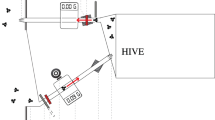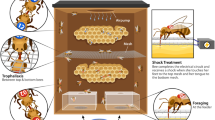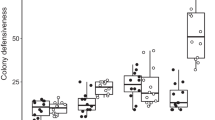Abstract
We analyzed the foraging and recruitment activity of single foragers (Apis mellifera), exploiting low reward rates of sucrose solution. Single employed foragers (test bees) were allowed to collect 2.0 m sucrose solution delivered by a rate-feeder located at 160 m from the hive for 2 h. Flow rates varied between 1.4 and 5.5 µl/min. The individual behavior of the test bees was registered both at the hive and the food source, and the social output was calculated as the number of incoming bees arriving at the feeder per hour (henceforth: arrival rate). Incoming bees were captured once they landed at the feeder and assigned to one of three categories according to their foraging experience and hive interactions with the test bee: inspector, reactivated, or inexperienced bees. Both the waggle-runs performed per hour of foraging by test bees and the social output attained, increased with the reward rate. Also the number of hive-stays and the trophallactic-offering contacts performed by test bees were positively correlated with the arrival rate. For the highest reward rates, the duration of Nasonov-gland exposure at the feeding place was higher, and the arrival of most of the incoming bees occurred shortly after the test bee landed at the feeding platform. Thus, in addition to hive-interactions, landing of incoming bees at the food source is promoted by olfactory and/or visual information provided by the test bees. The proportions of inspector, reactivated, and inexperienced bees changed depending on the reward rate offered. Therefore, not only the occurrence and intensity of the recruitment-related behaviors performed by the test bees, but also the stimulation required by each category of incoming bees, determined the social output observed.


Similar content being viewed by others
References
Bateson M, Kacelnik A (1995) Accuracy of memory for amount in the foraging starling (Sturnus vulgaris). Anim Behav 50:431–443
Biesmeijer JC, Vries H de (2001) Exploration and exploitation of food sources by social insect colonies: a revision of the scout-recruit concept. Behav Ecol Sociobiol 49:89–99
De Marco RJ, WM Farina (2001) Changes in food source profitability affect the trophallactic and dance behavior of forager honeybees (Apis mellifera L). Behav Ecol Sociobiol 50:441–449
Farina WM (1996) Food-exchange by foragers in the hive—a means of communication among honey bees? Behav Ecol Sociobiol 38:59–64
Fernández PC, Farina WM (2001) Changes in food source profitability affect Nasonov gland exposure in honeybee foragers Apis mellifera L. Insectes Soc 48:366–371
Fernández PC, Farina WM (2002) Individual recruitment in honeybees Apis mellifera L: the effect of the food source profitability on the rate of bees arriving at the feeding place. Acta Ethol 4:103–108
Free JB (1987) Pheromones of social bees. Chapman & Hall, London
Frisch K von (1967) The dance language and orientation of bees. Harvard University Press, Cambridge, Mass
Gil M (2001) La recolección de alimento en la abeja Apis mellifera L: Estudio de las interacciones sociales relacionadas con el reinicio de la actividad de forrajeo. Thesis, University of Buenos Aires
Gil M, Farina WM (2002) Foraging reactivation in the honeybee Apis mellifera L: factors affecting the return to known nectar sources. Naturwissenschaften 89:322–325
Gould JL, Henerey M, MacLeod MC (1970) Communication of direction by the honey bee. Science 169:544–554
Istomina-Tsvetkova KP (1960) Contribution to the study of trophic relations in adult worker bees. XVII International Beeke** Congress, Bologna-Rome 1958
Nixon HL, Ribbands CR (1952) Food transmission within the honeybee community. Proc R Soc Ser B 140:43–50
Núñez JA (1966) Quantitative Beziehungen zswischen den Eigenschaften von Futterquellen und dem Verhalten von Sammelbienen. Z Vgl Physiol 53:142–164
Núñez JA (1970) The relationship between sugar flow and foraging and recruiting behaviour of honey bees (Apis mellifera L.). Anim Behav 18:527–538
Núñez JA (1971) Beobachtungen an sozialbezogenen Verhaltensweisen von Sammelbienen. Z Tierpsychol 28:1–18
Núñez JA (1977) Nectar flow by melliferous flora and gathering flow by Apis mellifera ligustica. J Insect Physiol 23:265–275
Núñez JA (1982) Honeybee foraging strategies at a food source in relation to its distance from the hive and the rate of sugar flow. J Apic Res 21:139–150
Pflumm WW (1969) Stimmungsänderungen der Biene während des Aufenthalts an der Futterquelle. Z Vgl Physiol 65:299–323
Seeley TD (1983) Division of labour between scouts and recruits in honeybee foraging. Behav Ecol Sociobiol 12:253–259
Seeley TD (1986) Social foraging by honeybees: how colonies allocate foragers among patches of flowers. Behav Ecol Sociobiol 19:343–354
Seeley TD (1994) Honey bee foragers as sensory units of their colonies. Behav Ecol Sociobiol 34:51–62
Seeley TD (1995) The wisdom of the hive. Harvard University Press, Cambridge, Mass
Seeley TD, Towne WF (1992) Tactics of dance choice in honeybees: do foragers compare dances? Behav Ecol Sociobiol 30:59–69
Seeley TD, Camazine S, Sneyd J (1991) Collective decision-making in honeybees: how colonies choose among nectar sources. Behav Ecol Sociobiol 28:277–290
Tautz J (1996) Honeybee waggle dance: recruitment success depends on the dance floor. J Exp Biol 199:1375–1381
Tautz J, Sandeman DC (2003). Recruitment of honeybees to non-scented food sources. J Comp Physiol A (in press)
Thom C, Seeley TD, Tautz J (2000) A scientific note on the dynamics of labour devoted to nectar foraging in a honey bee colony: number of foragers versus individual foraging activity. Apidologie 31:737–738
Vogel S (1983) Ecophysiology of zoophilic pollination. In: Lange OL, Nobel PS, Osmond CB, Ziegier H (eds) Physiological plant ecology III. Springer, Berlin Heidelberg New York, pp 559–624
Wenner A, Wells P (1990) Anatomy of a controversy. Columbia University Press, New York
Wilson EO (1971) The insect societies. Belknap Press of Harvard University Press, Cambridge, Mass
Winston M (1987) The biology of the honey bee. Harvard University Press, Cambridge, Mass
Zar JH (1984) Biostatistical analysis, 3rd edn. Prentice-Hall, Englewood Cliffs, NJ
Acknowledgements
We are deeply indebted to T.D. Seeley for valuable comments on the original manuscript, and A. Wainselboim for language help. We also thank L. Moffatt for comments and suggestions throughout the study. This study was partially supported by funds from ANPCYT (PICT 98-03103) and by the University of Buenos Aires and CONICET. The present study complies with the current laws of the state country in which experiments were performed.
Author information
Authors and Affiliations
Corresponding author
Additional information
Communicated by M. Giurfa
Rights and permissions
About this article
Cite this article
Fernández, P.C., Gil, M. & Farina, W.M. Reward rate and forager activation in honeybees: recruiting mechanisms and temporal distribution of arrivals. Behav Ecol Sociobiol 54, 80–87 (2003). https://doi.org/10.1007/s00265-003-0607-2
Received:
Revised:
Accepted:
Published:
Issue Date:
DOI: https://doi.org/10.1007/s00265-003-0607-2




